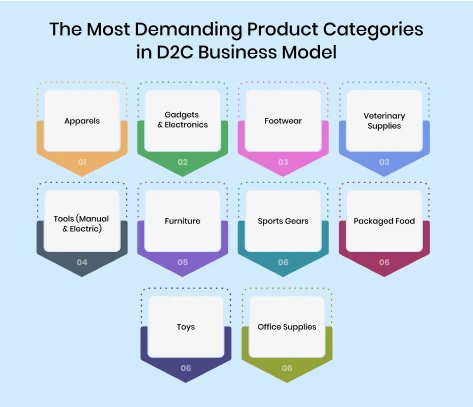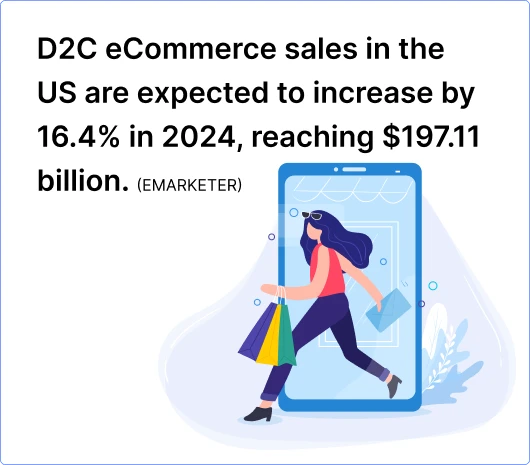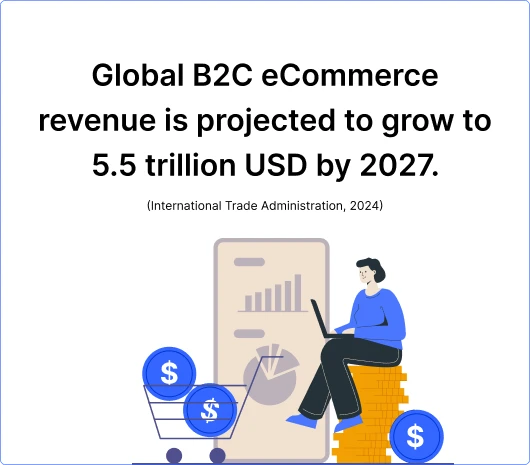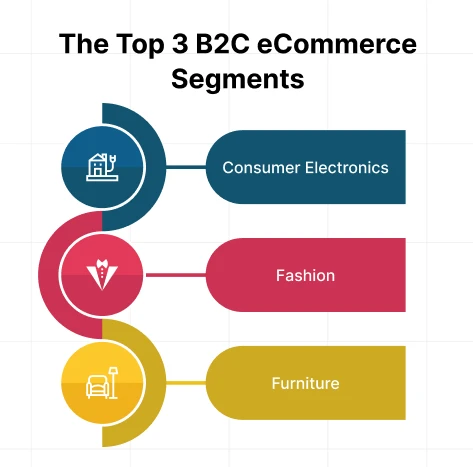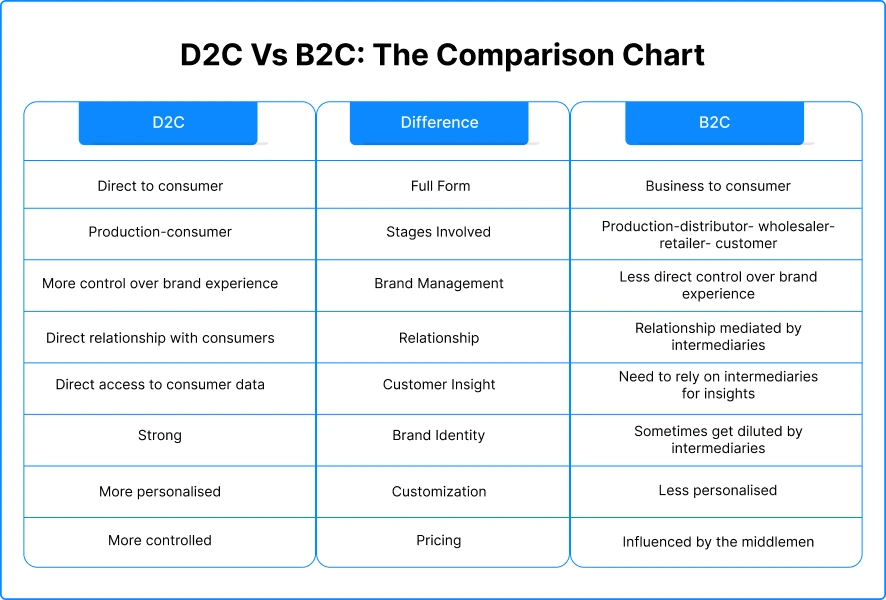D2C Vs B2C Model: Understanding the Main Differences
- April 16, 2024
- 23 mins read
- Listen
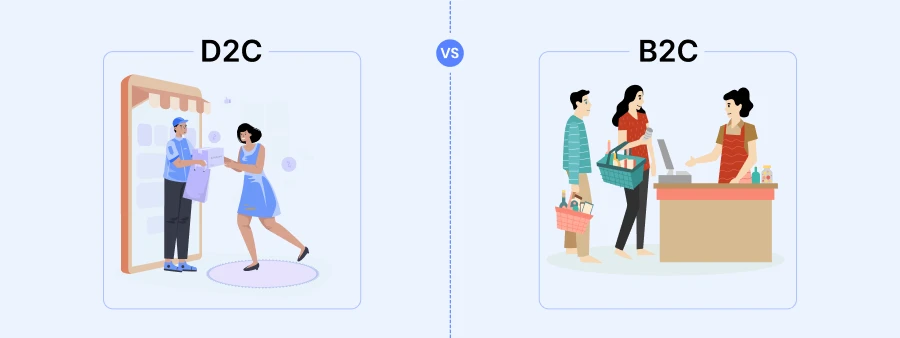
Suppose you’re on your phone, scrolling through endless options to buy that perfect pair of shoes. But have you ever wondered how those products actually reach you? Well, that’s where the magic of retail comes into play, and it’s divided into two main camps: Direct-to-Consumer (D2C) and Business-to-Consumer (B2C). Think of D2C and B2C as two different paths that brands take to reach you, the shopper.
A recent report by Statista shows that in 2022, eCommerce sales in the United States were approximately $857 billion. And by 2027, experts think that number will go up to over $1.5 trillion. So, it’s clear that online shopping is really popular and getting even bigger. But when it comes to online selling, different brands have their different ways of selling products. Most fall into one of these two groups: D2C or B2C.
Each of these 2 categories, D2C and B2C has its own special things when it comes to getting customers and advertising. Let’s take a closer look at D2C compared to B2C, and see the good and not-so-good sides of each.
What is the Direct to Consumer (D2C) Business Model?
D2C (Direct to Consumers) is a way of doing business where companies sell their products or services directly to people, without using any middlemen. Instead of going through distributors, wholesalers, or retailers, these companies sell straight to you.
In the traditional supply chain, products usually go from the manufacturer to distributors or wholesalers, then to retailers, and finally to consumers. But with D2C, that middle step is skipped. Manufacturers sell right to consumers, which means you can buy products directly from the people who make them.
This approach gives companies more control over how they sell their products. They can create products, promote them to the people they think will like them the most, and send them straight to their doorsteps. This way, they’re in charge of everything from start to finish, which can make the whole shopping experience better for you.
D2C isn’t just about selling things online. Some companies also have their physical stores where they only sell their in-house products. This is different from big departmental stores or stores that carry products of different brands. In D2C stores, the company gets to talk directly to you and help you out personally. It’s all about making sure you have a great experience when you buy from them.
How Does D2C Work?
To understand how D2C (Direct-to-Consumer) businesses work, first, let’s see how they are different from regular business setups. In traditional models, products pass through several stages—manufacturers, wholesalers, and retailers—before finally reaching the customers. At each step, there are changes in pricing and negotiations.
Nowadays, most D2C companies have their own online stores and sales channels, which need eCommerce fulfillment. Here, 3PL (third-party logistics) companies come into play. They offer services like storing products, picking and packing orders, shipping them, and even managing returns for other businesses.
Managing all the logistics tasks on their own isn’t the most efficient way for D2C businesses to grow. That’s why many of them choose to outsource these tasks to 3PL providers.
In essence, 3PL acts as a crucial link between D2C businesses and their customers. By taking care of fulfillment tasks, they allow companies to focus on important things like marketing and maintaining product quality, while ensuring orders are efficiently and smoothly delivered to customers.
Advantages of the D2C Model
D2C businesses have introduced a buyer-driven form of commerce that’s become more popular recently due to the benefits it offers for both companies and customers. Here’s why!
-
Sales Control
As a D2C (Direct-to-Consumer) business, you’re in charge of everything from selling to marketing and delivering products. One of the best advantages of D2C is you deal directly with customers, which helps you build stronger connections with them. This also lets you gather lots of information about customers, which helps you change your different business strategies and how you serve customers to better fit their needs.
-
Customer Focus
Since here businesses deal directly with consumers, they can better understand customer needs, preferences, and feedback. This direct relationship allows for personalized experiences and tailored products or services, leading to higher customer satisfaction and loyalty.
-
Cost Reduction
In a D2C business, you don’t have to share your earnings with middlemen like stores or distributors. Instead, you deal straight with the people buying your products, saving money by skipping those extra steps. This gives you a better chance to make more profit and have extra cash to put back into your business.
-
Fewer Mediators
In traditional ways of selling, middlemen like wholesalers, distributors, and stores make things cost more for brands. With more steps in the process, each person takes a piece, making the final price higher for customers.
But with the D2C model, manufacturers can sell straight to customers without any middlemen. This means lower prices for buyers and more profit for the companies making the products.
-
Valuable Insights
For D2C businesses, knowing about their customers (customer analytics) is super important. They gather useful info like names, ages, what people buy, and when they shop. This helps companies suggest more things based on customer preferences, sell more to current customers, and find new segmented markets.
-
Better Customer Service
Companies that sell directly to customers know the best about their product offerings compared to wholesalers, and retailers. This is why they can provide better assistance with returns, fixing things, and answering queries. Because these companies are responsible for their products, it also makes customers trust them more.
-
Stronger Relationships
The primary focus for D2C companies is meeting customer requirements and expectations. Since brands deal directly with customers, they can make things more personal to keep customers coming back and stick to them for a longer time span.
-
Agility
D2C businesses often rely on other companies to handle their logistics. This allows them to focus on what really matters: their products and their customers. By outsourcing, they save time and money, which can be used to adapt to market changes, track trends, and increase overall flexibility.
-
Higher Profitability
Businesses that skip middlemen can save money and make more profit. By avoiding extra fees from retailers, they can focus on growing and creating new products.
-
Innovation
In a D2C model, companies can launch new products in a smaller way and check how customers are responding to them. They can try them out with specific groups of people and get their opinions. This helps them figure out what customers like, make things people actually buy, and get better over time. In a setup without D2C, stores usually prefer to stick with what sells well among their customers rather than making things for the retailers to keep in their shops.
-
Global Expansion
One big advantage of direct-to-consumer (D2C) businesses is that they can easily expand globally. As they don’t need to rely on middlemen like retailers or distributors, they can sell their products directly to customers worldwide. This means they can reach more people and grow their business faster in different countries and regions.
-
Transparency and Authenticity
D2C companies often stay open and honest with customers about various aspects, including product ingredients, manufacturing processes, pricing, and business practices. By providing clear and accurate information, D2C brands build trust with customers, leading to stronger brand loyalty and repeat purchases.
Authenticity in D2C businesses involves staying true to the brand’s values, mission, and identity. D2C brands emphasize their unique story, craftsmanship, and dedication to quality, which resonates with customers seeking genuine and meaningful connections with the products they buy.
Disadvantages of the D2C Model
While the direct-to-consumer (D2C) model offers several advantages, it also comes with its own set of challenges and disadvantages. Such as:
-
Increased Accountability
As D2C businesses don’t work with wholesalers, distributors, or retailers, they have to handle everything from making the products to storing them and sending them to customers. This means they need to put in extra effort to organize all these tasks, including handling returns to make sure everything runs smoothly.
Here one of the biggest disadvantages of D2C is companies need to spend more time and money on managing these tasks themselves instead of getting help from the middlemen.
-
Constrained by Product Range
D2C brands typically start with a focused range of products to maintain quality and control costs. However, this limited product range may not cater to the diverse needs of all customers. This can result in missed sales opportunities as customers may prefer a wider selection of products.
Most people still like to buy everyday things like food, or grossaries from retail stores. They’re used to it. But when it comes to things that are more personal, like smartphones, clothes, watches, or sunglasses, they’re more open to buying directly from brands. That’s why Direct-to-Consumer (D2C) brands mainly focus on stuff that’s personalized to you.
-
Fierce Competition
In lots of industries, selling directly to customers online has become really popular. This means there are a lot of companies all trying to sell similar things to the same group of people. This can make it tough for new companies to stand out and get customers to buy from them instead of someone else. Since there are so many companies competing, it can cost a lot of money to get people’s attention and convince them to buy your stuff. This might mean spending a ton on ads and marketing, which can be tough for smaller businesses with limited funds.
-
Prioritizing Sales Targets
One of the greatest disadvantages of the D2C model is the pressure to meet sales targets. This means companies may focus more on pushing products to meet their sales goals rather than prioritizing what’s best for the customers. It can lead to aggressive sales tactics or pushing products that may not be the right fit for the customer’s needs. Altogether it can sometimes overshadow the goal of providing excellent customer service and building long-term relationships with customers.
-
Handling Order Volume
One drawback of the Direct-to-Consumer (D2C) business model is coping with the rising number of orders. As D2C companies expand and gain more customers, they frequently encounter difficulties in efficiently managing the surge in orders.
This can cause delays in processing, shipping, and delivering orders, potentially leading to unhappy customers and damaging the company’s reputation. Moreover, increasing operations to handle higher order volumes demands investment in infrastructure, technology, and workforce, putting pressure on resources and affecting profitability.
-
Challenges in Logistics
Managing shipping and fulfillment processes can be complex and costly for D2C businesses, especially if they operate on a large scale or offer a wide range of products. Coordinating timely delivery, handling returns, and managing inventory levels across multiple locations can pose significant logistical challenges.
Building and maintaining a robust distribution network can be also expensive. This includes establishing warehouses, fulfillment centers, and delivery partnerships to ensure efficient and reliable product distribution. Managing these logistics requires significant investment in infrastructure and technology.
-
Infrastructure and Operations-Related Costings
Creating a direct-to-consumer (D2C) way of selling needs strong foundations, like building a website, implementing payment gateways, integrating customer relationship management (CRM) systems, and organizing how things get sent out. Making and keeping these things going smoothly takes a lot of money and time, especially for new or small businesses.
D2C companies often face scalability challenges related to overall business structure. Rapid growth may require additional investments to handle increased website traffic, order processing, inventory management, and customer service demands. Failure to scale the infrastructure accordingly can lead to performance issues, downtime, and ultimately, dissatisfied customers.
What is the Business to Consumer (B2C) Model?
The Business-to-Consumer (B2C) model is a common business structure where companies sell products to customers through different channels. In simple terms, any company that sells things to regular people is considered a B2C business.
Unlike the direct-to-consumer (D2C) approach, in B2C, the company doesn’t sell its products through its own platform. Instead, it acquires products from manufacturers and sells them through various outlets like stores or websites.
B2C brands work with intermediaries such as wholesalers, retailers, or distributors to deliver their products to customers. Currently, B2C online shopping is larger than D2C, but its growth rate isn’t very high. In 2023, the global B2C market was valued at $4.4 trillion, with annual growth typically remaining below 10%.
Major B2C companies, such as Amazon, Walmart, and eBay, operate large online marketplaces where customers can purchase products from a wide range of brands.
Advantages of the B2C Model
The B2C model offers businesses numerous advantages in terms of market reach, revenue generation, brand building, customer engagement, and scalability, making it a popular choice for companies looking to sell their product offerings to their customers.
Next, let’s look into the benefits in detail!
-
Expanded Reach and Scalability
B2C businesses have the potential to reach a larger audience directly. Through various marketing channels such as social media, search engines, and traditional advertising, B2C companies can target specific demographics and increase brand visibility. With the rise of e-commerce platforms, B2C businesses can reach consumers globally, breaking geographical barriers and tapping into new markets without the need for physical storefronts.
B2C businesses can scale more rapidly as they can acquire customers on a larger scale without the need for complex negotiations or long sales cycles. Leveraging technology and automation, B2C companies can efficiently scale their operations to meet increasing demand. E-commerce platforms, for instance, allow businesses to handle a high volume of transactions without significant overhead costs.
-
Multi-Channel Distribution
This approach allows for increased flexibility and accessibility for customers, as they can choose to purchase through different channels based on their preferences. Whether it’s through a physical store, online website, mobile app, social media platform, or third-party marketplace, the multi-channel distribution strategy ensures that businesses can reach consumers wherever they are, maximizing their potential customer base and sales opportunities.
Opting for a major platform enables small businesses to access advantages like shipping and warehousing services, aiding in cost control. Additionally, online marketplaces like Amazon itself have extensive knowledge of their customers’ buying behaviors, which can be utilized to enhance sales strategies when selling through their platforms.
-
Enhanced Understanding of Customers
B2C companies can learn more about who their customers are, what they like, and how they behave. By collecting data from interactions with customers, such as purchases, website visits, and social media engagement, B2C companies can build detailed profiles of their customers. This enhanced understanding allows them to tailor the products, services, and marketing strategies to better meet the needs and preferences of their customers. Ultimately, this leads to higher customer satisfaction, loyalty, and increased sales.
-
Established Distribution Networks
B2C businesses selling to consumers have already set up efficient systems for delivering their products or services. These networks often include partnerships with distributors, shipping companies, warehouses, and logistics providers, allowing for smooth and reliable delivery to customers’ doorsteps.
With established distribution networks, B2C companies can ensure timely delivery, reduce shipping costs, and provide a better overall shopping experience for their customers. Additionally, having these networks in place enables businesses to scale their operations more easily and reach a broader audience without logistical constraints.
-
Enhanced Accessibility
Customers have the flexibility to purchase products through various channels such as eCommerce websites, physical retail stores, or even social media platforms. This convenience allows them to buy products anytime and from anywhere, contributing to increased sales.
-
Elimination of Inventory Storage and Warehousing Needs
In this setup, B2C businesses selling through retailers or distributors don’t need big warehouses. Instead, they let retailers or distributors store and manage the inventory until it’s sold. This saves manufacturers money on storage and other costs. It also makes things run smoother by keeping inventory close to where it’s sold. Overall, it’s a win-win for everyone involved, making inventory management better and saving money on expenses.
-
Reduced Risk and Initial Investment
One major benefit of B2C businesses is the lower risk and initial investment needed. Starting a B2C venture often requires less money and carries less risk compared to other types of businesses. Since many B2C businesses sell through distributors or retailers, they don’t have to spend a lot on expensive infrastructure. Instead, they can concentrate on building their brand and attracting customers without worrying about shipping and delivery costs. This reduced investment and risk make the B2C model attractive to entrepreneurs and small businesses with limited resources who want to enter the market.
Disadvantages of B2C Business Model
While the B2C model offers numerous advantages, it also comes with several drawbacks, such as:
-
Lower Profitability
Since there are middlemen such as distributors, wholesalers, and retailers between the customers and companies, the profit gets reduced by a big amount. Each middleman takes a share of the profit, reducing the overall amount the company makes from selling its products.
Also, consumers in the B2C market tend to be more price sensitive. They often look for the best deals and are willing to switch brands or providers for even minor cost savings. This puts pressure on businesses to keep prices competitive, which can squeeze profit margins.
-
Managing Multiple Orders at a Time is Tough
It’s tough to manage lots of orders at once: B2C businesses get orders from all over—like wholesalers, social media, and online stores all at the same time. Handling all these orders requires good skills in keeping track of inventory and delivering the right stuff to the right place.
-
Dependency on the Middlemen
B2C companies depend on many different people to sell their products such as distributors, and retailers. This dependency limits their ability to fully control how customers go through the buying process and the overall experience they have while purchasing products or services.
-
Supply Chain Complexity
Maintaining a smooth supply chain can be challenging for B2C businesses, especially those with diverse product offerings. Any disruptions in the supply chain, such as delays or quality issues, can negatively impact customer satisfaction and sales.
D2C Vs B2C: The Main Differences
Till now we have discussed the concept, pros, and cons of D2C and B2C. D2C (Direct-to-Consumer) and B2C (Business-to-Consumer) have different purposes and ways of doing things. They both aim to solve problems, make customers happy, sell products, and keep customers coming back.
D2C focuses on building a direct relationship with customers and lets someone else handle selling and delivering the products. B2C businesses, on the other hand, can reach more customers and offer more products through different channels.
One big difference between D2C and B2C is that all D2C models are part of B2C, but not all B2C is D2C. Both sell products to the people who use them, and you can say D2C is a type of B2C.
Here the only similarity between the D2C and B2C business models is both sell their products to the customers. Next, let’s look into the major differences between these 2 business models.
-
Distribution Pathways
D2C: In the D2C model, companies sell directly to customers without any middlemen involved. They do this through their online stores, physical shops, and catalogs. This way, sellers have more say in how they interact with customers and provide better customer experiences.
B2C: B2C companies usually sell their products through middlemen like shops, wholesalers, and online marketplaces such as Amazon. The manufacturer or seller sells to these middlemen who then sell to you, the customer. They can also use social media sites like Instagram and Facebook to sell their products, as these platforms have their own online stores.
-
Scale and Reach
D2C: Here D2C businesses may initially have a smaller reach since they rely solely on their own channels, but they can scale more efficiently by leveraging digital marketing, social media, and eCommerce platforms to reach a global audience.
B2C: B2C companies can potentially reach a wider audience by leveraging the distribution networks of wholesalers, retailers or distributors.
-
Brand Management
D2C: With this model, brands can build a closer bond with their customers because they interact directly with them. They can control how they communicate to the customers about their brands, engage with users in a better way, and collect customer feedback for further improvements, making the connection stronger.
B2C: In a B2C setup, companies don’t usually have direct contact with their customers. Instead, customers deal with online shops or retailers, not the actual brand behind the products.
-
Pricing Control
D2C: D2C businesses have more control over their pricing structure since they sell directly to consumers. They can set prices based on their production costs, value proposition, and market positioning without interference from intermediaries.
B2C: B2C pricing may be influenced by retailers or distributors who set their own prices based on various factors such as competition, market demand, and profit margins.
-
Information and Insights from Customers
D2C: Selling directly to customers lets businesses gather lots of useful information about them, like what they buy and how they behave. This helps in understanding customers better and planning marketing that’s just right for them.
B2C: When businesses sell through middlemen, they don’t always get to collect as much data about their customers. This means they might miss out on important insights that could help them improve their products or services.
-
Brand Building
D2C: Such businesses highly focus on building a good brand reputation among their customers. They can communicate their brand values, stories, and unique selling propositions more effectively through direct customer interactions.
B2C: B2C often involves building brand awareness and loyalty through various marketing channels. However as the final sale is typically made by the retailer, it may dilute the manufacturer’s brand presence.
-
Customization
D2C: When businesses sell directly to customers, they can make products and services more personalized according to what customers like.
B2C: In this model, the focus is often on how customers experience the store they’re buying from. While interactions might be personalized to some extent, it’s more about the shop itself rather than the brands behind the products.
-
Control Over Customer Experience
D2C: In D2C, the manufacturer or brand has full control over the customer experience since they interact directly with the end consumers. This allows for more personalized customer experiences, from marketing messages to post-purchase support.
B2C: In B2C, the manufacturer or service provider has less control over the customer experience since the product passes through intermediaries who may have their own branding, business strategies, and customer service standards.
-
Quickness and Adaptability
D2C: When businesses sell directly to customers, they can make decisions faster, and assist customers better. This happens because all operations are straightforward, efficient, and most importantly directly managed by these D2C companies only.
B2C: Making decisions and adjusting to what customers want might take longer because there are many steps involved with different groups handling the products before they finally reach customers.
D2C Business Examples: 2 Successful Brands
1. American Giant
American Giant has a distinct brand identity: they specialize in selling American-made clothing at reasonable prices. Initially, the brand was focused solely on producing hoodies. However, they have since expanded their product range to include various other clothing items such as t-shirts, sweatpants, jackets, and accessories, all manufactured with the same dedication to quality and domestic production. While American Giant has only a few physical retail stores, their eCommerce business is really big and is still expanding.
American Giant’s approach stands in contrast to many other apparel brands that opt for overseas manufacturing to cut costs. Instead, the company prioritizes local production, thereby supporting American workers and communities, while also ensuring that the product quality is top-notch.
2. Paleo Treats
Specialized in offering snacks and desserts, Paleo Treats focuses on foods akin to those consumed by our ancestors during the Paleolithic era such as lean meats, fish, fruits, vegetables, nuts, and seeds.
Paleo Treats gained popularity among health-conscious consumers seeking convenient, pre-packaged snacks that suit their dietary preferences. The company’s products are known for being made with natural ingredients, free from grains, gluten, dairy, and refined sugars, making them suitable for individuals following paleo, primal, or gluten-free lifestyles.
Through its D2C model, Paleo Treats sells directly to consumers via its website, without any intermediaries like retailers or distributors. This direct approach enables the company to maintain control over product quality, customer service, and brand messaging.
B2C Examples: 2 Successful Brands
1. Apple
This is one of the best B2C examples to look into. Apple’s success in selling directly to consumers (B2C) shows how a brand can become a big part of people’s lives by making innovative and cool products. They sell their stuff online, in their stores, and through other sellers.
Apple’s way of selling involves making products that work well together. Some people don’t like this because, for example, their MacBook might not work smoothly with their Android phone. But others are fine with it and enjoy being part of the Apple world. You can see this in how services like iCloud, Apple Music, and the App Store all work smoothly across Apple devices.
Apple also offers great after-sales assistance like tech support, software updates, and warranties to make sure customers are happy.
2. Nike
Nike sells its products directly to customers through different places. This includes their official website, Nike stores, and other retail stores that sell Nike stuff. Nike found out early that if a B2C company wants to connect to its customers, branding and marketing are the best ways. By teaming up with famous athletes and celebrities and making cool ads, Nike makes a connection with customers that’s more than just about what they sell.
People loved Nike’s swoosh logo and the “Just Do It” ads. Nike put up ads on billboards and made inspiring TV commercials. That’s how they came up with cool products like Air Jordan shoes and Dri-FIT clothes. Nike’s mix of great performance and stylish designs has made a lot of people like their stuff.
How Does REVE Chat Help You to Offer Excellent Customer Service?
Whether you are handling a B2C or D2C business with an online presence, REVE Chat’s AI-powered customer engagement software is here to elevate your customer service game across your website, mobile app, and other social media platforms such as Facebook, Viber, Instagram, Telegram, and WhatsApp.
In addition to providing exceptional customer service, REVE Chat also offers a smart AI chatbot capable of automating various business operations, including customer assistance. This means your customers can receive support round-the-clock, even outside of regular business hours or when all of your support reps are busy.
Curious to see the difference it can make for your business? Take advantage of our 14-day free trial today and discover firsthand how REVE Chat can revolutionize your approach to customer service. So, SIGN UP now.

